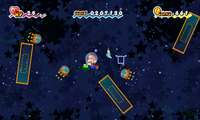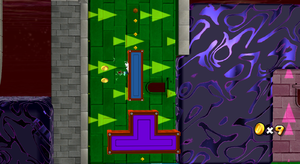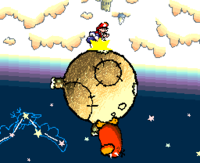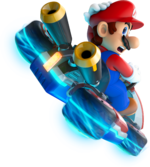Gravity: Difference between revisions
AgentMuffin (talk | contribs) No edit summary |
No edit summary |
||
| (2 intermediate revisions by 2 users not shown) | |||
| Line 1: | Line 1: | ||
[[File:SMG Dark Matter Plant Gravity Wall.png|thumb|A [[gravity field]] pulls [[Mario]] towards [[dark matter]] | [[File:SMG Dark Matter Plant Gravity Wall.png|thumb|300px|A [[gravity field]] pulls [[Mario]] towards [[dark matter]] in ''Super Mario Galaxy'']] | ||
'''Gravity''' is a theoretical force that draws two or more objects together. While gravity points in a consistent direction in most | '''{{wp|Gravity}}''' in the [[Super Mario (franchise)|''Super Mario'' franchise]] is a theoretical force that draws two or more objects together. While gravity points in a consistent direction in most ''Super Mario'' media, some games have mechanics that revolve around altered and planetary gravity. Gravity itself informs other game mechanics, such as the presence of [[pit]]s as an obstacle. In 3D platforming games, shadows are usually cast along the direction of gravity, to help show how objects are aligned in space. | ||
==History== | |||
<!--This only covers appearances where gravity can be altered or plays a central role in the plot.--> | |||
== | |||
===''Super Mario World 2: Yoshi's Island''=== | ===''Super Mario World 2: Yoshi's Island''=== | ||
[[File:RaphaelTheRavensCastle2.png|thumb|left| | [[File:RaphaelTheRavensCastle2.png|thumb|left|Gravity in the battle against [[Raphael the Raven]] allows him and Yoshi to run around on the [[moon]].]] | ||
Altered gravity in ''[[Super Mario World 2: Yoshi's Island]]'' is featured only in the boss fight of [[Raphael The Raven's Castle]], where [[Yoshi]] must run around the [[moon]] and [[Ground Pound]] the [[Stump]]s to attack [[Raphael the Raven]] on the other side. Yoshi is always shown upright; the arena rotates under him. | |||
{{br}} | {{br}} | ||
===''Yoshi Topsy-Turvy''=== | ===''Yoshi Topsy-Turvy''=== | ||
Gravity in ''[[Yoshi Topsy-Turvy]]'' is a key gameplay mechanic. The player can manipulate gravity and tilt the world accordingly by tilting [[Game Boy Advance]] left or right, resulting in items, enemies tilting in the same direction, or sometimes even obstacles such as [[boulder]]s. | |||
{{br}} | {{br}} | ||
===''Super Mario'' series=== | ===''Super Mario'' series=== | ||
====''Super Mario Galaxy'' / ''Super Mario Galaxy 2''==== | ====''Super Mario Galaxy'' / ''Super Mario Galaxy 2''==== | ||
Gravity in ''[[Super Mario Galaxy]]'' and ''[[Super Mario Galaxy 2]]'' can have its direction expressed by the shape and appearance of a planetoid, but is actually controlled by invisible game objects that direct gravity toward the surface of basic shapes:<ref>[//youtube.com/watch?v=QLH_0T_xv3I&lc=UgzPATZZz3gnzZAYd3F4AaABAg.9H3VViQ_kFI9H3jSMeTVDu]</ref><ref>[//kuribo64.net/objectdb/smg.php?game=2]</ref> | |||
*''' | *'''<code>GlobalPlaneGravity</code>''': Gravity vectors point in a consistent parallel direction, toward a plane. This can work like gravity in other games, or point in other directions like upside down or sideways. There is a variant with a finite hitbox, <code>GlobalPlaneGravityInBox</code>. In 2D sections, areas with different planar gravities may be indicated with [[gravity field]]s. | ||
*'''Sphere''': Gravity vectors point toward a sphere, as is typical of a planet. | *'''Sphere''': Gravity vectors point toward a sphere, as is typical of a planet. | ||
*''' | *'''<code>GlobalCubeGravity</code>''': Gravity vectors point parallel to the faces of a cube, with abrupt transitions along the diagonals from the edges. | ||
*''' | *'''<code>GlobalWireGravity</code>''': Gravity vectors point toward a line-based path. | ||
*''' | *'''<code>GlobalConeGravity</code>''': Gravity vectors point toward the curved surface of a conical frustum. Examples include the [[Sea Slide Galaxy#Ocean Pudding Planet|Ocean Pudding Planet]] in [[Sea Slide Galaxy]], and the [[Toy Time Galaxy#Frozen Dessert Area|giant ice cream cone]] in [[Toy Time Galaxy]]. | ||
*''' | *'''<code>GlobalDiskTorusGravity</code>''': Gravity vectors point toward the edge of an open disk, creating a torus (doughnut)-shaped field. | ||
*''' | *'''<code>GlobalDiskGravity</code>''': Gravity vectors point toward the surface of a closed disk, rounded between faces in the space around the edge. | ||
*'''Wedge''': Gravity vectors point toward a concave shape, that of the curved ramps in the [[Good Egg Galaxy]] [[Good Egg Galaxy#Starting planet|starting planet]]'s secret room. Another example on the same planet is the curved part of the walkway up the tower. | *'''Wedge''': Gravity vectors point toward a concave shape, that of the curved ramps in the [[Good Egg Galaxy]] [[Good Egg Galaxy#Starting planet|starting planet]]'s secret room. Another example on the same planet is the curved part of the walkway up the tower. | ||
*''' | *'''<code>GlobalBarrelGravity</code>''': Only found in ''Super Mario Galaxy 2''. The gravity vector field curves around the center axis of a cylinder. Two examples are the [[Tall Trunk Galaxy#Wood Drum Planet|Wood Drum Planet]] and [[Tall Trunk Galaxy#Wood Circle Cut Planet|Wood Circle Cut Planet]] in [[Tall Trunk Galaxy]], each with relatively perpendicular 2D sections to each other; the former snaps Mario to a cylindrical shell, and the latter to a circular cross-section. | ||
In practice, this leads to four main conceptual models of gravity: | In practice, this leads to four main conceptual models of gravity: | ||
| Line 42: | Line 39: | ||
====''Super Mario Odyssey''==== | ====''Super Mario Odyssey''==== | ||
Gravity in ''[[Super Mario Odyssey]]'' can be altered in certain 2D sections accessed by [[8-bit pipe]]s. Some use gravity fields. Others, such as ones seen in the [[Moon Kingdom]], have Mario hopping to circular 2D planets with different gravity. | |||
The Moon Kingdom, [[Dark Side]], and [[Darker Side]] also have lower gravity, which allows Mario to perform much higher jumps than usual. | The Moon Kingdom, [[Dark Side]], and [[Darker Side]] also have lower gravity, which allows Mario to perform much higher jumps than usual. | ||
===''Super Paper Mario''=== | ===''Super Paper Mario''=== | ||
[[File:SPM Outer Limits.PNG|thumb|Mario in the [[Outer Limits]]]] | [[File:SPM Outer Limits.PNG|thumb|left|Mario in the [[Outer Limits]] in ''Super Paper Mario'']] | ||
Gravity in Chapter 4 of ''[[Super Paper Mario]]'' is different than in other appearances, due to taking place in [[Outer Space]]. In Chapters 4-1 and 4-3, gravity is nonexistent, allowing Mario and his party to navigate freely. Pressing any direction on the [[nwiki:Wii Remote|Wii Remote]]'s D-Pad {{button|wii|Pad}} will automatically propel the player in the given direction. When [[flip]]ped into 3D, Mario can only move laterally due to the lack of other controls for vertical movement. The player cannot [[stomp]] enemies in zero gravity and must instead use [[Squirps]]' Squirt Beam. | |||
Chapter 4 of ''[[Super Paper Mario]]'' | |||
Chapter 4-2 takes place on [[Planet Blobule]], which has low gravity, allowing the characters to jump much higher than normal and to fall much slower. | Chapter 4-2 takes place on [[Planet Blobule]], which has low gravity, allowing the characters to jump much higher than normal and to fall much slower. | ||
| Line 60: | Line 55: | ||
{{main|Anti-gravity}} | {{main|Anti-gravity}} | ||
[[File:MK8 Mario Anti-Gravity Standard Kart Artwork.png|thumb|Mario driving a kart with anti-gravity.|150px]] | [[File:MK8 Mario Anti-Gravity Standard Kart Artwork.png|thumb|Mario driving a kart with anti-gravity.|150px]] | ||
Gravity in ''[[Mario Kart 8]]'' and [[Mario Kart 8 Deluxe|its Nintendo Switch version]] appears in the form of [[anti-gravity]], which allows vehicles to drive on upside-down and vertical sections of courses, and to perform [[Spin Boost]]s. | |||
{{br|left}} | |||
==Gallery== | |||
<gallery> | |||
YTT-Spirit of Surprises Screenshot3.png|The [[Spirit Who Loves Surprises]] teaching [[Yoshi]] how to use Gravity in ''Yoshi Topsy-Turvy'' | |||
SPM Whoa Zone Gravity Switch Vertical.png|Mario in the Whoa Zone near a gravity switch in ''Super Paper Mario'' | |||
</gallery> | |||
==References== | ==References== | ||
Revision as of 15:37, May 6, 2024
Gravity in the Super Mario franchise is a theoretical force that draws two or more objects together. While gravity points in a consistent direction in most Super Mario media, some games have mechanics that revolve around altered and planetary gravity. Gravity itself informs other game mechanics, such as the presence of pits as an obstacle. In 3D platforming games, shadows are usually cast along the direction of gravity, to help show how objects are aligned in space.
History
Super Mario World 2: Yoshi's Island
Altered gravity in Super Mario World 2: Yoshi's Island is featured only in the boss fight of Raphael The Raven's Castle, where Yoshi must run around the moon and Ground Pound the Stumps to attack Raphael the Raven on the other side. Yoshi is always shown upright; the arena rotates under him.
Yoshi Topsy-Turvy
Gravity in Yoshi Topsy-Turvy is a key gameplay mechanic. The player can manipulate gravity and tilt the world accordingly by tilting Game Boy Advance left or right, resulting in items, enemies tilting in the same direction, or sometimes even obstacles such as boulders.
Super Mario series
Super Mario Galaxy / Super Mario Galaxy 2
Gravity in Super Mario Galaxy and Super Mario Galaxy 2 can have its direction expressed by the shape and appearance of a planetoid, but is actually controlled by invisible game objects that direct gravity toward the surface of basic shapes:[1][2]
GlobalPlaneGravity: Gravity vectors point in a consistent parallel direction, toward a plane. This can work like gravity in other games, or point in other directions like upside down or sideways. There is a variant with a finite hitbox,GlobalPlaneGravityInBox. In 2D sections, areas with different planar gravities may be indicated with gravity fields.- Sphere: Gravity vectors point toward a sphere, as is typical of a planet.
GlobalCubeGravity: Gravity vectors point parallel to the faces of a cube, with abrupt transitions along the diagonals from the edges.GlobalWireGravity: Gravity vectors point toward a line-based path.GlobalConeGravity: Gravity vectors point toward the curved surface of a conical frustum. Examples include the Ocean Pudding Planet in Sea Slide Galaxy, and the giant ice cream cone in Toy Time Galaxy.GlobalDiskTorusGravity: Gravity vectors point toward the edge of an open disk, creating a torus (doughnut)-shaped field.GlobalDiskGravity: Gravity vectors point toward the surface of a closed disk, rounded between faces in the space around the edge.- Wedge: Gravity vectors point toward a concave shape, that of the curved ramps in the Good Egg Galaxy starting planet's secret room. Another example on the same planet is the curved part of the walkway up the tower.
GlobalBarrelGravity: Only found in Super Mario Galaxy 2. The gravity vector field curves around the center axis of a cylinder. Two examples are the Wood Drum Planet and Wood Circle Cut Planet in Tall Trunk Galaxy, each with relatively perpendicular 2D sections to each other; the former snaps Mario to a cylindrical shell, and the latter to a circular cross-section.
In practice, this leads to four main conceptual models of gravity:
- Planetary gravity, which draws Mario in on all sides of the planet. This allows Mario to traverse the underside of a planet. An example of this is the mini-planets in the Gusty Garden Galaxy.
- Absolute gravity, which pulls Mario down, regardless of the planet's center. Mario is expected to slide down slopes, rather than rotating to stand on them. Falling off of the planet acts as a bottomless pit, causing Mario to lose a life even if he is not pulled into a black hole. An example is Honeyhive Galaxy's starting planet.
- Outward gravity, which pulls Mario to the sides of a planet when he is inside one. Examples include the Tower Planet in Bowser's Galaxy Reactor, and the Warp Pipe area on the inside of the Asteroid Planet in Good Egg Galaxy.
- Toroidal gravity, also referred to as[citation needed] "orbital" or "fall forever" gravity, which pulls Mario around the curved surface of a cylindrical planetoid. Another example is the Abandoned Rocketship Planet in Space Storm Galaxy.
Gravity is also manipulated in several levels, using Arrow Switches, which change the direction of gravity of the surrounding area; gravity spotlights, which push Mario toward a surface or another place like a tractor beam; and the grates and dirt patches in Flipsville Galaxy, which flip Mario's gravity when crossed. Pull Stars, Sling Stars, and Launch Stars allow Mario to ignore gravity while they are used.
Black holes use gravity to draw Mario or Luigi into them if they get too close, causing them to lose a life.
While shadows are still usually cast along the direction of gravity, there are exceptions when other spatial information is more important. For example, coins cast their shadows toward honey walls to show their position in space, even though it is not because of gravity that Bee Mario sticks to these walls. These exceptions are handled with invisible game objects similar to the ones that control gravity.
Super Mario Odyssey
Gravity in Super Mario Odyssey can be altered in certain 2D sections accessed by 8-bit pipes. Some use gravity fields. Others, such as ones seen in the Moon Kingdom, have Mario hopping to circular 2D planets with different gravity.
The Moon Kingdom, Dark Side, and Darker Side also have lower gravity, which allows Mario to perform much higher jumps than usual.
Super Paper Mario

Gravity in Chapter 4 of Super Paper Mario is different than in other appearances, due to taking place in Outer Space. In Chapters 4-1 and 4-3, gravity is nonexistent, allowing Mario and his party to navigate freely. Pressing any direction on the Wii Remote's D-Pad ![]() will automatically propel the player in the given direction. When flipped into 3D, Mario can only move laterally due to the lack of other controls for vertical movement. The player cannot stomp enemies in zero gravity and must instead use Squirps' Squirt Beam.
will automatically propel the player in the given direction. When flipped into 3D, Mario can only move laterally due to the lack of other controls for vertical movement. The player cannot stomp enemies in zero gravity and must instead use Squirps' Squirt Beam.
Chapter 4-2 takes place on Planet Blobule, which has low gravity, allowing the characters to jump much higher than normal and to fall much slower.
Chapter 4-4 takes place in the Whoa Zone, which has normal gravity. However, entering certain doors and pipes may place the characters on the walls or ceiling of a room. Later in the level, gravity switches are found, which change the direction of the player's personal gravity.
Mario Kart 8 / Mario Kart 8 Deluxe
- Main article: Anti-gravity
Gravity in Mario Kart 8 and its Nintendo Switch version appears in the form of anti-gravity, which allows vehicles to drive on upside-down and vertical sections of courses, and to perform Spin Boosts.
Gallery
The Spirit Who Loves Surprises teaching Yoshi how to use Gravity in Yoshi Topsy-Turvy




